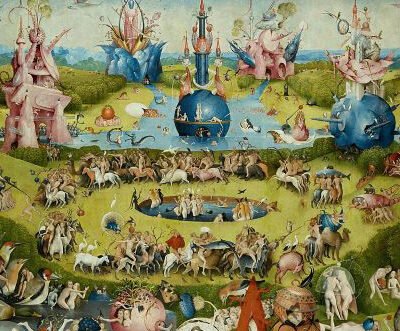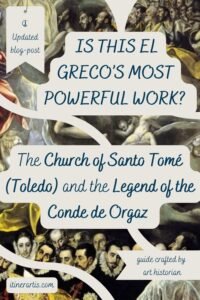Discovering Reality Anew: Top 10 Reina Sofia Highlights [Deciphered by Art Historian]
Sheltered in the vibrant heart of Madrid, the Museo Nacional Centro de Arte Reina Sofia highlights as a beacon of contemporary art. Its striking presence is a testament to Spain’s rich cultural tapestry. However, this museum is not just a house for art; it’s a dynamic space where the very perceptions of reality are challenged and redefined.
- Discovering the Essence of Reina Sofia Highlights
- A Journey Through Perception with Reina Sofia Highlights
- 1. “Cards and Dice” by Georges Braque (1914) [the first of Reina Sofia Highlights]
- 2. “Totalizer” by Francis Picabia (1922)
- 3. “The Great Masturbator” by Salvador Dalí (1929)
- 4. “A World” by Ángeles Santos (1929) [Reina Sofia Highlights and Universes]
- 5. “Man with a Pipe” by Joan Miró (1925) [Reina Sofia Highlights and Smoke]
- 6. “The Musician's Table” by Juan Gris (1926)
- 7. “Guernica” by Pablo Picasso (1937): the Ultimate Reina Sofia Highlight
- 8. “Anti-Moon (Antiluna)” by Pinot Gallizio (1957)
- 9. “Anthropometry [ANT 56]” by Yves Klein (1957)
- 10. “Superimposition of Grey Matter” by Antoni Tàpies (1961)
- Beyond the Canvas — The Cultural Echoes of Reina Sofia Highlights
- The Transformative Journey Through Reina Sofia Highlights
“Art does not reproduce what is visible; rather, it makes visible what is not always so.”
Paul Klee
Discovering the Essence of Reina Sofia Highlights
The Reina Sofia Museum is a place where art and history come alive side by side. Its design is a cool mix of old and new, with brick walls from the past and glass walkways that seem to lead right into tomorrow. It’s like stepping into a storybook where every corner has a different tale.
Post last updated on March 12, 2025 (originally published on January 20, 2024) by Roberta Darie.
Nevertheless, this spot hasn’t always been about art. It started out as a hospital, way back in the day. But as years zipped by, it transformed into one of Spain’s go-to places for modern art in Madrid. It’s like the museum itself grew up, from helping heal people to inspiring them.
Now, let’s talk about what hangs on the walls and fills the rooms—the art. The Reina Sofia highlights are all about the cool stuff from the 20th century. That’s when artists started to get really creative with their work, making you see ordinary things in extraordinary ways. They played with colors and shapes, making things look dreamy or super weird on purpose.
When you walk through the museum, you’ll see why it’s famous for its surrealism and abstract art. These pieces are not just to decorate the place. They poke at your brain, making you think, “Wow, what if?” That’s the magic of the Reina Sofia highlights. They’re not just paintings or sculptures; they’re like secret doors to new worlds.

A Journey Through Perception with Reina Sofia Highlights
Envision stepping into a realm where each painting and sculpture whispers a secret: “Reality is often an illusion.” This is the transformative encounter that awaits you at the Reina Sofia Museum. Here, art transcends silent observation on the gallery walls. Instead, it leaps forth, compelling you to take a deeper look and challenge your perceptions.
Moreover, the Reina Sofia highlights I’ve meticulously chosen exemplify this very essence. They confront and stretch your understanding of reality. As you gaze upon these works, they may contort and dance in your consciousness. They present familiar scenes with an unexpected twist—vivid colors, fluid shapes, and enigmatic scenes that defy initial comprehension.
Furthermore, the artists behind these creations sought to disrupt the status quo. Their ambition was to provoke thought and evoke novel emotions. This is precisely the adventure that unfolds as you navigate through the museum’s corridors. Each piece of art stands as an enigma, inviting you to decipher its hidden messages.
1. “Cards and Dice” by Georges Braque (1914) [the first of Reina Sofia Highlights]
Prepare yourself for the inaugural captivating turn in your Reina Sofia exploration. As you meander through the expansive halls, you’ll unexpectedly encounter a piece that commands attention. Entitled “Cards and Dice,” this work by Georges Braque is not just any creation—it’s a revolutionary force in the art world.
Remarkably, this painting emerges as a centerpiece, a crown jewel within Reina Sofia’s highlights. Nestled among other masterpieces, it demands notice. But what sets it apart? It serves as an integral element in the Cubism movement. Cubism, much like a complex riddle for the art enthusiast, challenges viewers to see beyond appearances. And Braque, indeed, played this visual game with unparalleled skill.
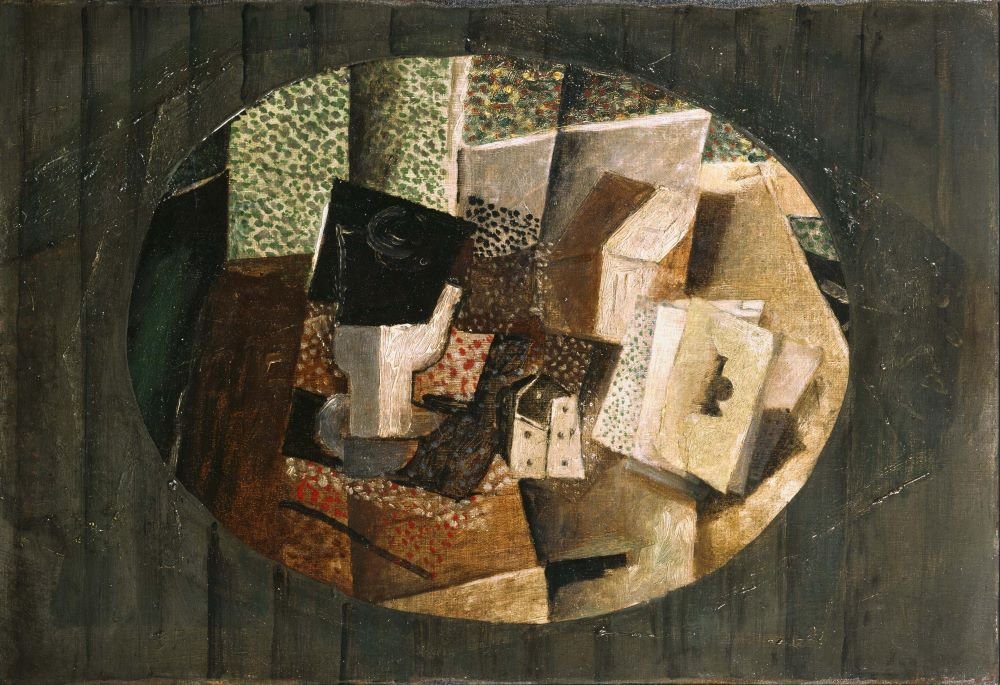
Unveiling the Essence of Cubism: Georges Braque’s “Cards and Dice”
Georges Braque, undeniably, revolutionized the art scene. He didn’t merely paint; he, along with his comrade Picasso, flipped art on its head, birthing the movement known as Cubism. Picture this: taking reality, fragmenting it into shards, and then reassembling it into something utterly unprecedented and transformative. That was Braque’s genius at play.
His renowned creation, “Cards and Dice,” shines prominently in the Reina Sofia Museum. This piece is pivotal because it encapsulates the harmonious collaboration between Braque and Picasso, akin to two virtuoso musicians in a flawless duet. Crafted in the year 1914, it represents a zenith of creativity for the pair.
Upon encountering “Cards and Dice,” you’ll perceive more than mere objects on canvas. Braque ingeniously manipulates your vision, shattering and rearranging shapes much like a complex jigsaw puzzle. Moreover, this work offers a glimpse into Braque’s future endeavors with collage, pioneering the use of everyday materials to craft something wholly novel.
This masterpiece is spotlighted among Reina Sofia highlights not solely for its aesthetic appeal but for its capacity to engage your intellect, compelling you to perceive the world from an entirely fresh perspective. It’s an invitation to let your thoughts unfurl and twist, challenging you to envision beyond the conventional.
Challenging Reality Through Cubist Lenses
So, how does “Cards and Dice” challenge our perception of reality? Braque deconstructs the mundane—cards, dice, a glass—inviting us to reconstruct them mentally. In this manner, he pushes us to question our understanding of form and space. As we engage with the artwork, we are compelled to navigate the blurred lines between representation and abstraction.
2. “Totalizer” by Francis Picabia (1922)
The Museo Nacional Centro de Arte Reina Sofia houses gems of modern art. Among these, “Totalizer” by Francis Picabia stands out. This masterpiece claims its space within the Reina Sofia highlights, captivating visitors with its enigmatic presence. It is strategically placed, inviting onlookers into the avant-garde world of the 1920s.
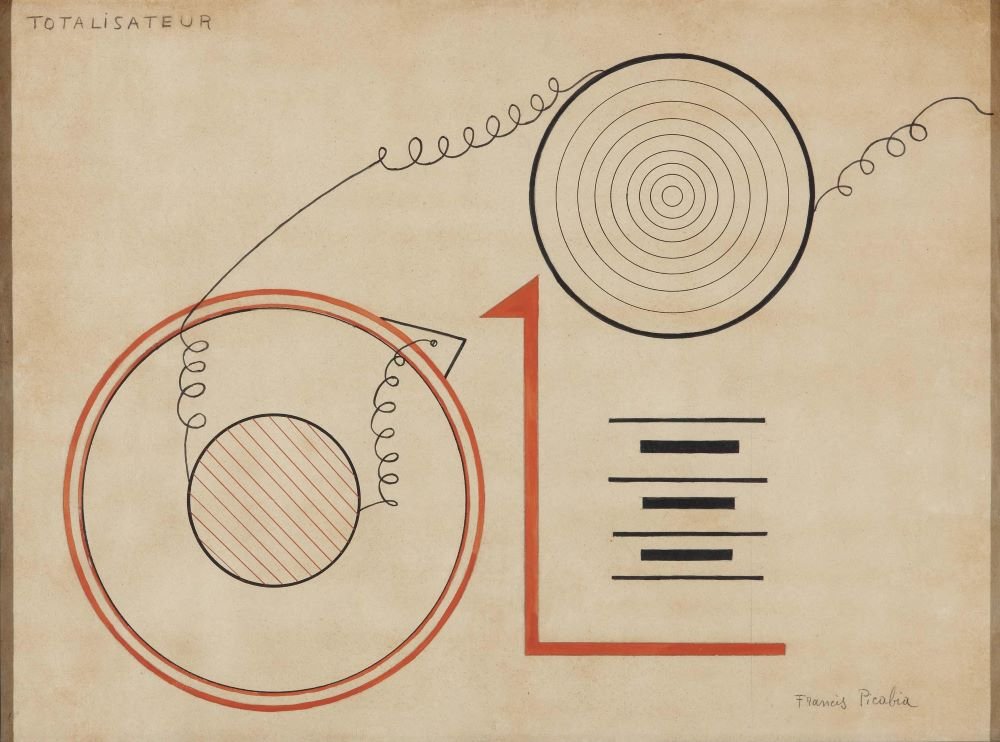
“Totalizer” by Francis Picabia: A Splendid Reina Sofia Highlight
Francis Picabia was an artist ahead of his time. Pushing the boundaries of what art could be. He dabbled in Dadaism, a cool art movement that loved to shake things up. And abstract art? He was all over it.
“Totalizer” isn’t just a painting; it’s like a time machine. Made in 1922, it’s full of the Dadaist attitude—defying the norm and laughing in the face of tradition. Picabia wasn’t just making art; he was making a statement. He wanted people to question what they saw, to look for the deeper story behind the swirls and shapes. And find out, that sometimes, meaning does not obey to reason.
When you see “Totalizer,” think of it as a puzzle. It’s not supposed to look like anything you know. It’s there to make you think, to stir up ideas, and to light up your imagination. This piece is a big deal at the Reina Sofia. It’s one of those Reina Sofia highlights that captures a moment when art was changing gears, speeding away from the past and into the future.
The Reality-Bending Impact of “Totalizer”
The piece dismantles traditional forms, reconstructing them into something new and unfamiliar. As we confront it, our perceptions shift. We are compelled to question our definitions of art and objecthood. Through Picabia’s vision, reality becomes a playground for the imagination.
3. “The Great Masturbator” by Salvador Dalí (1929)
This iconic piece finds its home among the Reina Sofia highlights, drawing in those who seek the surreal. It resides prominently, a beacon of Dalí’s enigmatic world, beckoning viewers to explore deeper narratives within its canvas.
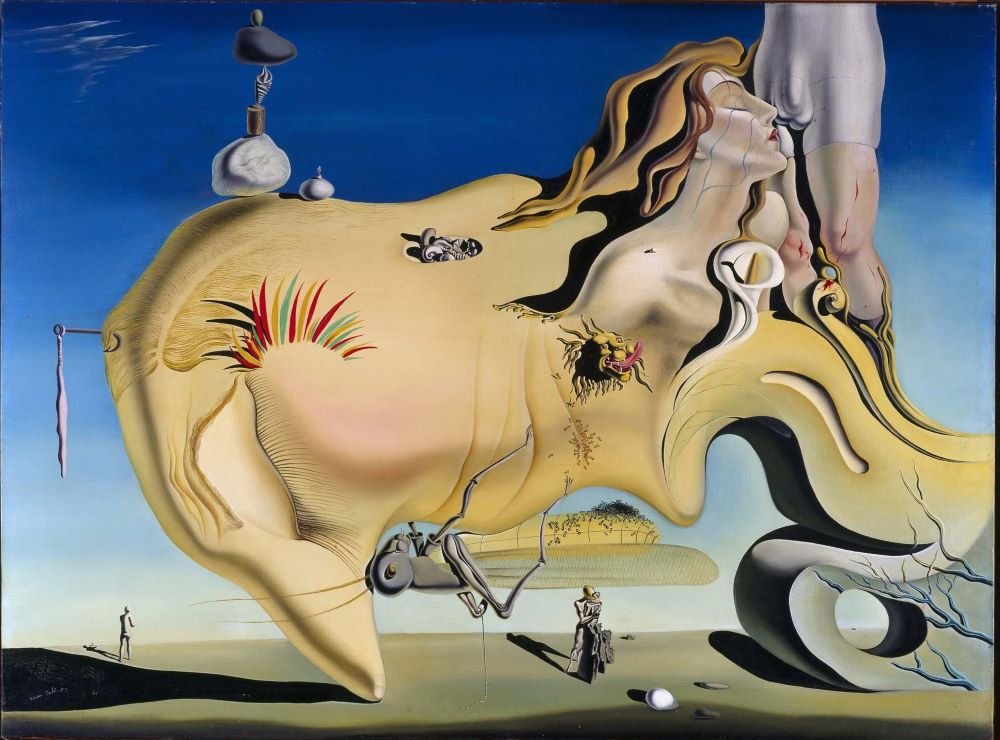
“The Great Masturbator” – A Surrealist Reina Sofia Highlight by Salvador Dalí
Dalí needs little introduction. His name conjures images of melting clocks and dreamlike landscapes. As a principal figure in Surrealism, Dalí’s impact is monumental. His works delve into the subconscious, combining technical precision with fantastical imagination. “The Great Masturbator” is a cornerstone of his legacy, showcasing his unique ability to warp reality on canvas.
“The Great Masturbator” is a study in psychological depth and symbolic complexity. Created in 1929, this painting is a hallmark of Surrealism’s golden age. It captures the essence of Dalí’s exploration into desire, anxiety, and the human psyche. Its historical significance lies in its power to disrupt the norm and redefine artistic boundaries.
Questioning Reality with Dalí’s Vision and Reina Sofia Highlights
How does Dalí’s masterpiece challenge our grasp on reality? Every element of “The Great Masturbator” invites a second look, a deeper analysis. Dalí paints not just images but emotions and thoughts, tangible yet ethereal. As we engage with the artwork, we’re drawn into a dialogue with our own subconscious. Reality bends under Dalí’s brush, urging us to question not what we see, but what we feel and think.
4. “A World” by Ángeles Santos (1929) [Reina Sofia Highlights and Universes]
As you meander through the Museo Nacional Centro de Arte Reina Sofia, pause to discover “A World” by Ángeles Santos. This painting is a celebrated Reina Sofia highlight, nestled in a gallery where the avant-garde spirit of the 1920s still breathes. It holds a place of honor, inviting viewers to step into a realm where imagination knows no bounds.
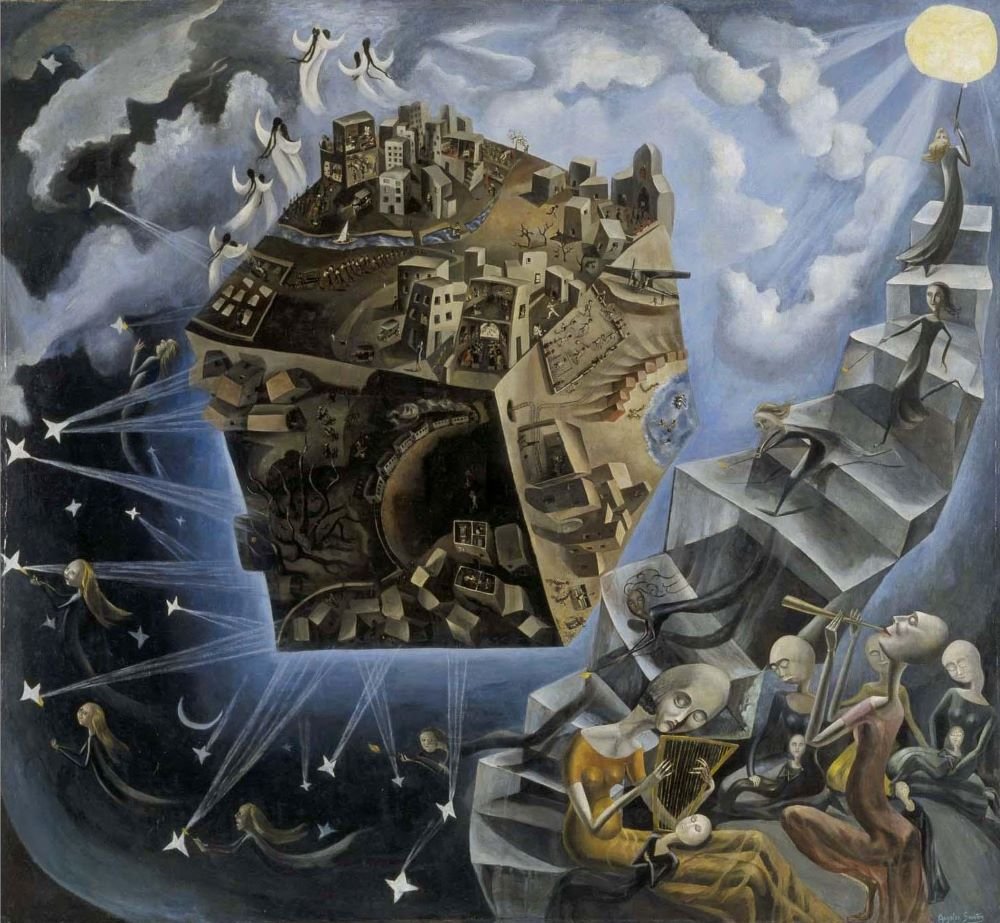
“A World” by Ángeles Santos: A Visionary Piece Among Reina Sofia Highlights
Ángeles Santos, a pivotal figure in Spanish art, broke through the barriers of her time with a singular vision. Her importance is profound, particularly as a woman in the early 20th-century art world. She carved a niche for herself with bold, dreamlike canvases. “A World” stands as a powerful testament to her talent and pioneering spirit.
You might describe “A World” as a symphony of the subconscious. Created when Santos was just 17, it resonates with historical significance. The painting reflects a blend of personal narrative and cosmic fantasy, a hallmark of her unique style. It is a piece that bridges movements, hinting at Surrealism while anchoring itself in something deeply personal.
The Reality-Bending Essence of Santos’ Creation
Santos crafts a landscape that defies logic, with floating figures and disjointed perspectives. Her work compels us to look beyond the physical world. It encourages us to ponder our place in the universe. As we delve into the painting, reality becomes a canvas of our own imagination. Here, reality is not fixed but fluid, and each viewer’s interpretation adds a new layer to its enigmatic beauty.
5. “Man with a Pipe” by Joan Miró (1925) [Reina Sofia Highlights and Smoke]
Journey through the Museo Nacional Centro de Arte Reina Sofia, and find yourself face to face with “Man with a Pipe” by Joan Miró. This masterpiece resides within an ensemble of Reina Sofia highlights, where Miró’s creations offer a dialogue between earth and sky. It stands out, capturing gazes and provoking thought among the museum’s visitors.
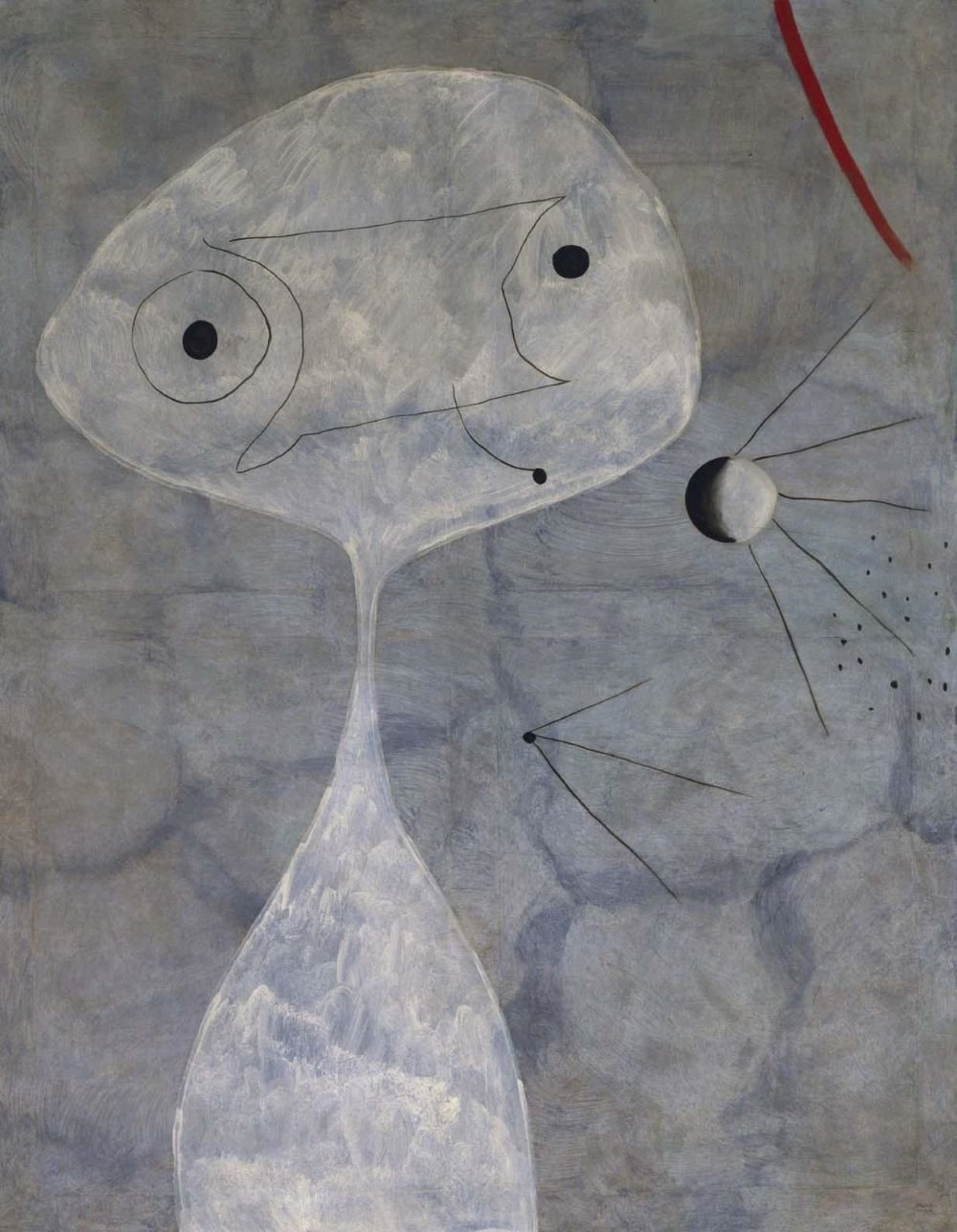
“Man with a Pipe” by Joan Miró: A Reina Sofia Artistic Highlight
Joan Miró, the mastermind behind this piece, is a giant in the art world. His significance is unparalleled, especially as a Surrealist who defied the conventional. His art dances between reality and fantasy, leaving a legacy that continues to inspire.
Miró’s “Man with a Pipe” is a vibrant echo of his genius. A visual poem. Crafted in 1925, it is a testament to Miró’s exploration of the subconscious. The painting’s historical significance is profound, marking a moment in art when the canvas became a space for innovation and wonder.
The Question of Reality in Miró’s Work
Miró plays with form and color, distorting the familiar into something otherworldly. The artwork beckons us to reconsider what we know. It invites us to see beyond the pipe, beyond the man, into a realm where reality is but a starting point for imagination.
6. “The Musician’s Table” by Juan Gris (1926)
Within the Museo Nacional Centro de Arte Reina Sofia’s storied halls, “The Musician’s Table” by Juan Gris takes center stage. This piece harmonizes with the Reina Sofia highlights, offering a visual melody that resonates through the museum’s modernist displays. It beckons admirers, nestled among the finest examples of Cubist artistry.
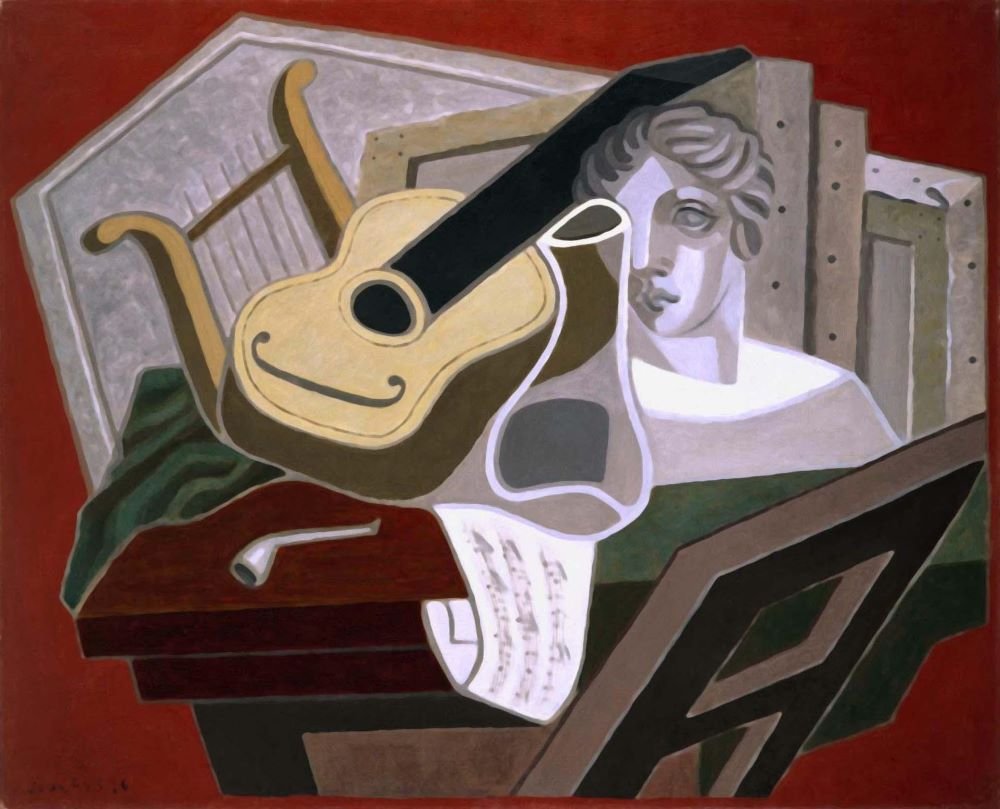
“The Musician’s Table”: A Symphony of Shape within Reina Sofia Highlights
Juan Gris stands tall as a pivotal figure in Cubism. His work is essential, shaping the movement with his distinct, refined approach. Gris brings a methodical precision to Cubism, setting him apart from his contemporaries. “The Musician’s Table” exemplifies his influential role in art, presenting a masterclass in geometric harmony.
“The Musician’s Table” is a Cubist masterpiece. Created in 1926, it showcases Gris’s mature style. The painting is a historical dialogue, speaking to the evolution of Cubism and its impact on modern art. It is a visual thesis on balance, form, and the interplay of light and shadow.
Questioning the Tangible: Gris’s Artistic Challenge in Reina Sofia Highlights
Gris dismantles the ordinary, reassembling it into an orchestrated arrangement of shapes. This artwork challenges us to see beyond the surface, to interpret the world as a composition of abstract elements. Reality, as depicted by Gris, becomes a puzzle for the mind to piece together.
7. “Guernica” by Pablo Picasso (1937): the Ultimate Reina Sofia Highlight
In the Museo Nacional Centro de Arte Reina Sofia, “Guernica” commands a solemn presence. This monumental work is the jewel in the crown of the Reina Sofia highlights. It resides in its own room, where the echoes of its past are palpable. Visitors find themselves not just viewing, but experiencing, the gravity of Picasso’s statement.

“Guernica” by Pablo Picasso: A Reina Sofia Masterpiece Echoing History
Pablo Picasso is synonymous with revolutionary art. His name carries weight, marking him as one of the most influential artists of the 20th century. As the father of Cubism and a pioneer in modernism, Picasso altered the course of art history. “Guernica” stands as a bold testament to his genius and his political engagement.
Painted in 1937, it captures the horrors of the bombing of the Basque town of Guernica during the Spanish Civil War. Its historical significance is immeasurable, serving as a perpetual reminder of war’s atrocities. The painting is a masterful blend of form, emotion, and political statement.
The Reality Distorted by “Guernica”
Picasso shatters the facade of normalcy with each stroke. The artwork confronts us with a fractured reality where pain and chaos reign. It forces us to question the nature of war and peace. In front of “Guernica,” reality is not only questioned; it’s mourned. It is an emotional journey that challenges viewers to reflect on the past and its impact on the human condition.
8. “Anti-Moon (Antiluna)” by Pinot Gallizio (1957)
As you explore the Museo Nacional Centro de Arte Reina Sofia, “Anti-Moon” by Pinot Gallizio emerges as a distinctive highlight. This intriguing piece is part of the Reina Sofia highlights, positioned among works that disrupted the art world in the mid-20th century. It captures the imagination, nestled in a space that celebrates innovation.
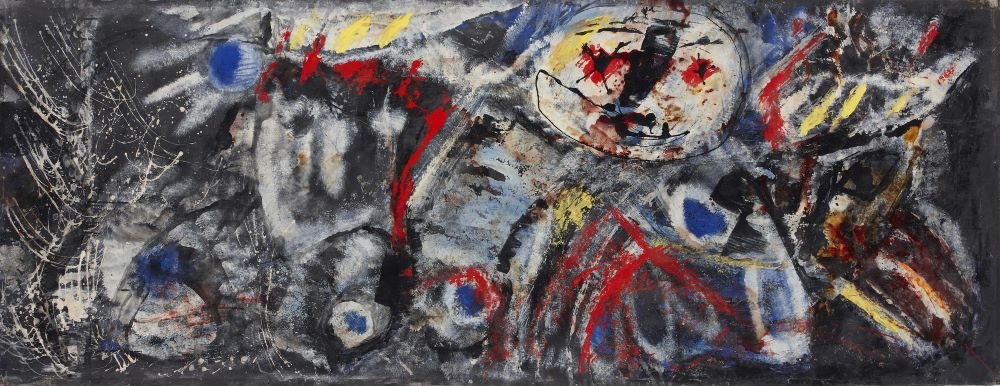
“Anti-Moon” by Pinot Gallizio: A Visionary Highlight at Reina Sofia
Pinot Gallizio’s role in the avant-garde scene is crucial. He was a founding member of the Situationist International, pushing boundaries in both art and thought. His importance lies in his experimental approach, which sought to merge art with everyday life.
“Anti-Moon” is a testament to his radical spirit. Created in 1957, it embodies the post-war yearning for new expression and meaning. The painting’s significance in art history is anchored in its innovation and its challenge to artistic norms.
The Reality Questioned by “Anti-Moon”
Gallizio’s work invites viewers into an abstract world where the conventional moon we know is reimagined. The artwork beckons us to consider alternative perspectives, urging us to see beyond our accepted constructs. It transforms reality into a concept ripe for re-examination. It engages visitors in a dialogue with the unknown, leaving them with a sense of wonder and a challenge to their perceptions of the familiar.
9. “Anthropometry [ANT 56]” by Yves Klein (1957)
In the Museo Nacional Centro de Arte Reina Sofia, “Anthropometry [ANT 56]” by Yves Klein offers a striking encounter. This piece is a star among the Reina Sofia highlights, displayed prominently to engage and provoke. It stands out as a bold statement within the museum’s contemporary collection.
![Yves Klein: Anthropometry [ANT 56] (1957) dry pigment in synthetic resin on cloth paper, Reina Sofía Museum, Madrid.](https://itinerartis.com/wp-content/uploads/2024/01/09-anthropometry-yves-klein.jpg)
“Anthropometry [ANT 56]” by Yves Klein: A Reina Sofia Sensation
Yves Klein, the creator of “Anthropometry,” is renowned for his innovative spirit. He left an indelible mark on post-war art with his conceptual approach. Klein is celebrated for his audacity and his signature International Klein Blue. His works, especially “Anthropometry,” challenge the status quo, making him an icon of modern art.
“Anthropometry [ANT 56]” is a radical departure from traditional painting techniques. Conceived in 1957, it captures Klein’s engagement with the human form and performance art. The work’s historical significance lies in its fusion of process and product, a significant milestone in the narrative of art.
Challenging Perceptions with “Anthropometry”
Klein’s technique—using the human body as a paintbrush—invites viewers to see beyond the canvas. The artwork disrupts our understanding of creation and representation. It transforms the act of painting into a live event, forever imprinted in blue.
10. “Superimposition of Grey Matter” by Antoni Tàpies (1961)
As visitors meander through the Museo Nacional Centro de Arte Reina Sofia, “Superimposition of Grey Matter” by Antoni Tàpies offers a moment of introspection. This piece, a true highlight among the Reina Sofia highlights, is thoughtfully placed amidst Spain’s most influential modern artworks. It invites a pause, a closer look, a deeper thought.
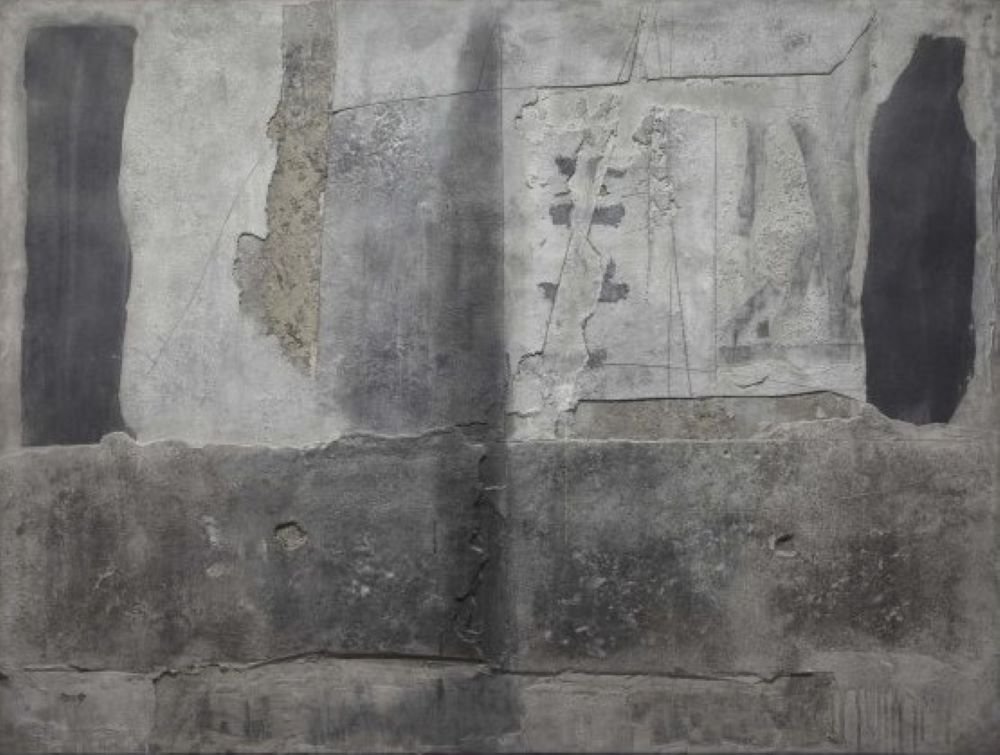
“Superimposition of Grey Matter” by Antoni Tàpies: A Textural Journey at Reina Sofia
Antoni Tàpies is not just an artist; he is a philosopher of materials. His works, pivotal in the art world, delve into the essence of matter and its spiritual significance. Tàpies is revered for his innovative use of unconventional materials, which cemented his role as a leader in the art informel movement. His “Superimposition of Grey Matter” is a canvas that speaks volumes.
Crafted in 1961, it is a rich textural landscape. It reflects Tàpies’ fascination with the alchemy of art—transforming base materials into visual poetry. Its significance in art history is anchored in its ability to transcend traditional painting, proposing a new, tactile form of expression.
Questioning Reality with Tàpies’ Textures
The layers and textures in “Superimposition of Grey Matter” challenge our perception of what constitutes a painting. The artwork blurs the lines between two-dimensional space and three-dimensional presence. It urges us to reconsider the boundary between art and life.
In the array of Reina Sofia highlights, Antoni Tàpies’ “Superimposition of Grey Matter” stands as more than a visual experience—it is a tactile dialogue with the viewer, compelling us to explore beyond sight, to feel with our eyes and think with our senses.
Beyond the Canvas — The Cultural Echoes of Reina Sofia Highlights
Embark on a journey at the Reina Sofia where art is more than just paint on canvas—it’s a mirror to society. Each masterpiece tells a story, reflecting the big themes that shape our world. They are not just artworks; they’re conversations with history.
Take Ángeles Santos’ “A World,” for instance. It’s a standout among the Reina Sofia highlights. Santos was just a teenager when she painted it, but she captured something timeless. Her work broke through the norms of her day. As a woman in the early 20th century, she carved out her own space with bold, dreamlike images.
These pieces at the Reina Sofia aren’t just cool to look at. They’ve been shaped by Spain’s history, and they’ve helped shape it too. They tell us about the times they were made in and about the people who made them. They’re like history books without words.
The Transformative Journey Through Reina Sofia Highlights
Seeing the Reina Sofia highlights in person is a game-changer. It’s one thing to see these artworks online or in books. But standing in front of them? That’s a whole different story. They’re powerful, they’re bold, and they have the potential to flip the way you see the world upside down.
These aren’t just paintings; they’re like portals. They pull you into stories, emotions, and ideas that can change you. They make you think and feel in ways you didn’t expect.
So, what happens after you leave the Reina Sofia? You might just find that your own take on reality has shifted a bit. These artworks challenge you to see beyond the everyday. They dare you to imagine, to question, and to open up to new possibilities.


